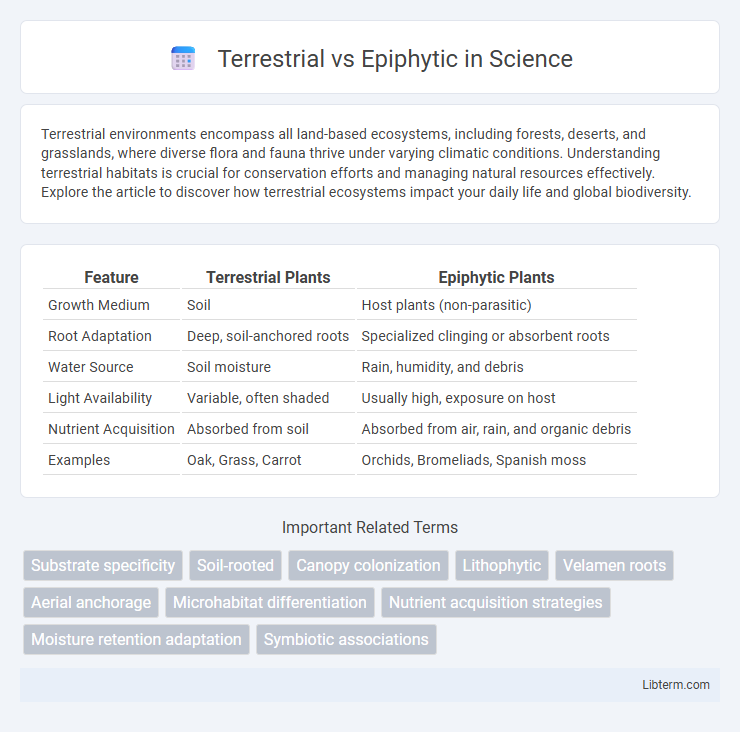Terrestrial environments encompass all land-based ecosystems, including forests, deserts, and grasslands, where diverse flora and fauna thrive under varying climatic conditions. Understanding terrestrial habitats is crucial for conservation efforts and managing natural resources effectively. Explore the article to discover how terrestrial ecosystems impact your daily life and global biodiversity.
Table of Comparison
| Feature | Terrestrial Plants | Epiphytic Plants |
|---|---|---|
| Growth Medium | Soil | Host plants (non-parasitic) |
| Root Adaptation | Deep, soil-anchored roots | Specialized clinging or absorbent roots |
| Water Source | Soil moisture | Rain, humidity, and debris |
| Light Availability | Variable, often shaded | Usually high, exposure on host |
| Nutrient Acquisition | Absorbed from soil | Absorbed from air, rain, and organic debris |
| Examples | Oak, Grass, Carrot | Orchids, Bromeliads, Spanish moss |
Introduction to Terrestrial and Epiphytic Plants
Terrestrial plants grow rooted in soil, obtaining nutrients and moisture directly from the ground, while epiphytic plants live on other plants, relying on air, rain, and debris for sustenance. Terrestrial species include most trees, shrubs, and grasses adapted for soil-based growth, whereas epiphytes like orchids and bromeliads have specialized roots and structures to capture water and nutrients without soil. Understanding the distinction between these growth habits highlights the diverse ecological adaptations in plant biology.
Defining Terrestrial Plants
Terrestrial plants grow directly in soil, relying on root systems to anchor and absorb water and nutrients essential for survival. These plants typically occupy ground-level habitats, where they compete for resources such as sunlight, space, and minerals in the soil. Unlike epiphytic plants, terrestrial species are independent of other plants for physical support, enabling them to thrive in diverse terrestrial ecosystems including forests, grasslands, and deserts.
What Are Epiphytic Plants?
Epiphytic plants grow non-parasitically upon other plants, primarily trees, using them as physical support rather than extracting nutrients. Unlike terrestrial plants rooted in soil, epiphytes absorb moisture and nutrients from the air, rain, and debris around them, often featuring specialized adaptations like aerial roots or water storage structures. Common examples of epiphytic plants include orchids, bromeliads, and Spanish moss, which thrive in tropical and subtropical forest ecosystems.
Key Differences Between Terrestrial and Epiphytic Growth
Terrestrial plants root in soil, absorbing nutrients and water directly from the ground, while epiphytic plants grow on other plants and obtain moisture and nutrients from the air or debris. Terrestrials often have deeper root systems for stability and resource extraction, in contrast to epiphytes which possess specialized aerial roots adapted for hanging and absorbing moisture. These growth strategies reflect adaptations to different ecological niches, with terrestrial plants dominating ground layers and epiphytes thriving in canopy environments.
Adaptations of Terrestrial Plants
Terrestrial plants have developed extensive root systems to anchor themselves and absorb water and nutrients from soil, while their thick cuticles minimize water loss in variable terrestrial climates. They exhibit stomatal regulation to optimize gas exchange and water retention, adapting to fluctuating environmental conditions. Structural support from lignified tissues enables terrestrial plants to withstand gravity and wind stress, distinguishing them from epiphytic counterparts.
Unique Adaptations of Epiphytes
Epiphytes exhibit unique adaptations such as specialized root structures that anchor them onto host plants without extracting nutrients, allowing access to sunlight in dense forests. They possess the ability to absorb moisture and nutrients directly from the air through their leaves, using trichomes or water-absorbing scales. These adaptations enable epiphytes like orchids and bromeliads to thrive in nutrient-poor environments where terrestrial plants may struggle.
Habitat and Environmental Requirements
Terrestrial plants grow in soil with access to nutrients and water, requiring well-drained environments and stable ground conditions to support root systems. Epiphytic plants thrive on other plants or structures, obtaining moisture and nutrients from air, rain, and debris, adapting to humid and well-ventilated habitats like forest canopies. The contrasting habitats reflect their environmental requirements, with terrestrial species needing fertile substrate and epiphytes relying on atmospheric moisture and minimal soil contact.
Common Examples of Terrestrial vs Epiphytic Species
Common terrestrial plants include species such as oak trees (Quercus spp.), dandelions (Taraxacum officinale), and sugarcane (Saccharum officinarum), which grow directly in soil and derive nutrients from the ground. Epiphytic species like orchids (Orchidaceae family), bromeliads (Bromeliaceae family), and Spanish moss (Tillandsia usneoides) grow on other plants for physical support but obtain moisture and nutrients from the air and debris around them. These adaptations highlight the distinct ecological niches and resource acquisition strategies between terrestrial and epiphytic plants.
Ecological Roles and Benefits
Terrestrial plants play a critical role in soil stabilization, nutrient cycling, and providing habitat for ground-dwelling organisms, contributing to ecosystem productivity and biodiversity. Epiphytic plants, commonly found on tree branches, enhance canopy microhabitats by trapping moisture and organic debris, supporting diverse invertebrates and facilitating nutrient input to forest ecosystems. Both growth forms promote ecological balance by maximizing spatial resource use and fostering species interactions within terrestrial and arboreal environments.
Challenges and Care in Cultivation
Terrestrial orchids require well-draining soil mixtures rich in organic matter to prevent root rot, posing challenges in maintaining proper moisture levels. Epiphytic orchids, adapted to grow on trees, need excellent air circulation and frequent misting to replicate their natural habitat, making humidity control essential. Both types demand precise temperature and light management, with terrestrial species often needing shade while epiphytes benefit from bright, indirect light for optimal growth.
Terrestrial Infographic

 libterm.com
libterm.com